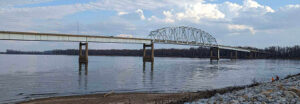The Drinking Water State Revolving Fund (DWSRF) helps water systems meet Safe Drinking Water Act goals and can also support infrastructure upgrades that reduce vulnerability to flooding.
| Encourages public-private partnerships | Targeted support for small communities |
Application cycle: Varies by state. Applicants should approach their state Drinking Water State Revolving Fund Program or EPA Regional Office for more information on specific deadlines.
Summary: The EPA’s Drinking Water State Revolving Fund (DWSRF) provides financial support to small municipalities for projects aimed at preserving the availability of clean drinking water. Small municipalities can leverage funding to incorporate flood resilience measures into efforts to improve, rehabilitate, or replace water infrastructure and create new water systems. This is a program supported by EPA and administered by states. Individual states may customize loan terms to meet the needs of small and disadvantaged communities. In addition, states have the option to set aside 15% of their DWSRF allocation specifically for local assistance programs, which include loans to acquire land or conservation easements for the protection of source waters and loans to provide funding to implement voluntary, incentive-based source water quality protection measures.
Eligible applicants: Existing privately-owned and publicly-owned community water systems and non-profit non-community water systems, including systems utilizing point of entry or residential central treatment, as well as new community water systems that represent cost-effective solutions to existing public health problems with serious risks.
Eligible activities: Construction of drinking water infrastructure projects, including modifications to ensure system capacity during flooding, planning for flooding events, and water quality treatment adjustments due to sea level rise; project planning and technical assistance may be eligible depending on the state.
Funding: Generally, no federal statutory maximums exist for eligible activities, although individual states allocate funds to prioritized projects and may impose additional limitations. In 2019, the Florida Department of Environmental Protection awarded DWSRF dollars to finance recovery efforts from Hurricane Michael, which included several projects ranging in value from $63,000 to nearly $400,000.
Cost share:
- Most assistance that municipalities receive through DWSRF is for loans that have to be repaid 100% to the DWSRF.
- Filter — Needs-Based Cost Sharing: Grants or principal forgiveness may be available for projects benefitting a small disadvantaged community (DAC), small severely disadvantaged community (SDAC), expanded small DAC/SDAC, or small non-disadvantaged communities with median household incomes (MHIs) less than 150% of the statewide MHI.
Application process:
- To apply, find your specific state program online.
- States rank the project applications they receive from water systems and produce a Project Priority List. States can tailor their ranking process while meeting the Safe Drinking Water Act (SDWA) requirement to give priority to projects that address the most serious risks to human health, ensure compliance with the SDWA, and assist systems most in need according to state affordability criteria.
- Filter — Small or Rural Communities: The Infrastructure Investment and Jobs Act (IIJA) requires that 49% of IIJA funds provided through the DWSRF General Supplemental Funding must be provided as grants and forgivable loans to disadvantaged communities.
- Filter — Public Private Partnerships: This program provides financial assistance to both publicly and privately owned community water systems for eligible drinking water infrastructure projects.


